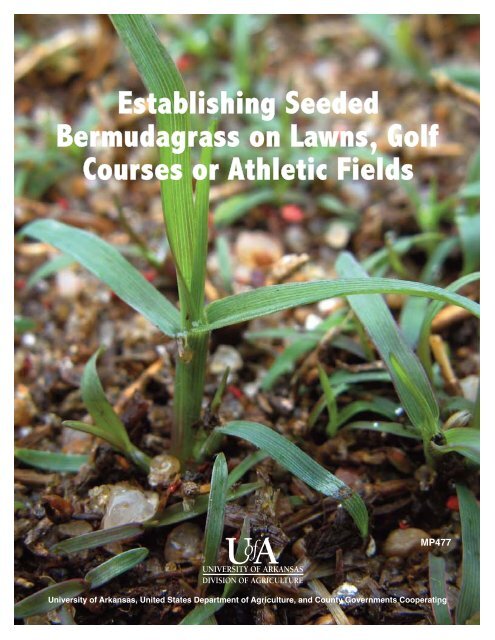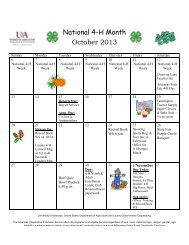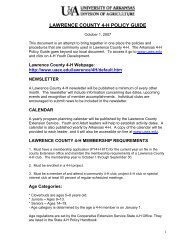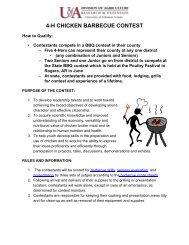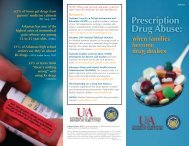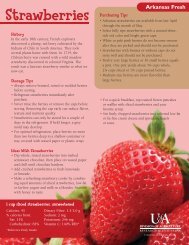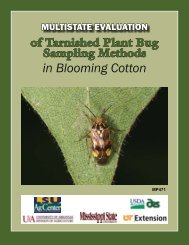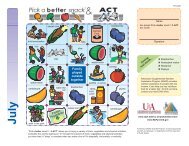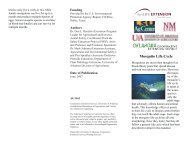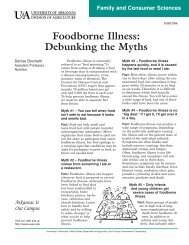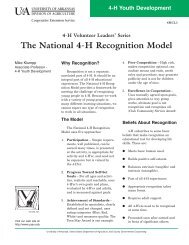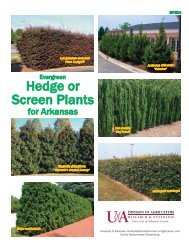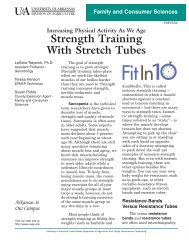Establishing Seeded Bermudagrass on Lawns, Golf Courses or ...
Establishing Seeded Bermudagrass on Lawns, Golf Courses or ...
Establishing Seeded Bermudagrass on Lawns, Golf Courses or ...
Create successful ePaper yourself
Turn your PDF publications into a flip-book with our unique Google optimized e-Paper software.
<str<strong>on</strong>g>Establishing</str<strong>on</strong>g> <str<strong>on</strong>g>Seeded</str<strong>on</strong>g><br />
<str<strong>on</strong>g>Bermudagrass</str<strong>on</strong>g> <strong>on</strong> <strong>Lawns</strong>, <strong>Golf</strong><br />
<strong>Courses</strong> <strong>or</strong> Athletic Fields<br />
MP477<br />
University of Arkansas, United States Department of Agriculture, and County Governments Cooperating
<str<strong>on</strong>g>Establishing</str<strong>on</strong>g> <str<strong>on</strong>g>Seeded</str<strong>on</strong>g> <str<strong>on</strong>g>Bermudagrass</str<strong>on</strong>g> <strong>on</strong><br />
<strong>Lawns</strong>, <strong>Golf</strong> <strong>Courses</strong> <strong>or</strong> Athletic Fields<br />
Auth<strong>or</strong><br />
Aar<strong>on</strong> Patt<strong>on</strong><br />
Assistant Profess<strong>or</strong> - Turfgrass<br />
Comm<strong>on</strong> bermudagrass (Cynod<strong>on</strong> dactyl<strong>on</strong>) is a<br />
warm-seas<strong>on</strong> turfgrass species used f<strong>or</strong> lawns, athletic<br />
fields and golf course tees, fairways and roughs<br />
in Arkansas. Comm<strong>on</strong> bermudagrass was first available<br />
by seed in the U.S. around 1940, but the first<br />
improved cultivar, Ariz<strong>on</strong>a Comm<strong>on</strong>, was released in<br />
the 1960s. Although bermudagrass seed has been<br />
available f<strong>or</strong> many years, its use in high-value turfs<br />
has increased in recent years due to the release of<br />
new cultivars with improved turfgrass quality similar<br />
to hybrid bermudagrass. An advantage to seeded<br />
bermudagrasses is they can be established at a<br />
lower cost compared to sodding <strong>or</strong> sprigging. Some of<br />
these new seeded cultivars have improved winter<br />
hardiness compared to hybrid bermudagrasses comm<strong>on</strong>ly<br />
used in Arkansas. This publicati<strong>on</strong> can be<br />
used as a guide by practiti<strong>on</strong>ers wishing to establish<br />
seeded bermudagrass in Arkansas.<br />
Cultivar Selecti<strong>on</strong><br />
Fact<strong>or</strong>s to c<strong>on</strong>sider when selecting a<br />
bermudagrass cultivar include seed availability,<br />
budget, maintenance level, pest tolerance, turf<br />
quality and adaptati<strong>on</strong>. However, the most<br />
imp<strong>or</strong>tant fact<strong>or</strong>s f<strong>or</strong> selecting a cultivar f<strong>or</strong> n<strong>or</strong>thern<br />
Arkansas are turfgrass quality and winter<br />
hardiness. Winter hardiness is an imp<strong>or</strong>tant fact<strong>or</strong><br />
in selecting cultivars since bermudagrass can be<br />
severely damaged periodically by severe winters in<br />
n<strong>or</strong>thern Arkansas. Other fact<strong>or</strong>s to c<strong>on</strong>sider are<br />
col<strong>or</strong>, spring dead spot resistance, establishment<br />
vig<strong>or</strong> and recovery.<br />
Rankings of turfgrass quality, winter hardiness,<br />
turf col<strong>or</strong>, spring dead spot resistance, establishment<br />
vig<strong>or</strong> and divot recovery am<strong>on</strong>g the commercially<br />
available seeded cultivars from the 2002 Nati<strong>on</strong>al<br />
Turfgrass Evaluati<strong>on</strong> Program bermudagrass trial<br />
are provided in Table 1, based up<strong>on</strong> data collected in<br />
transiti<strong>on</strong> z<strong>on</strong>e states like Arkansas. Additi<strong>on</strong>ally,<br />
the mean of these rankings is provided as well as a<br />
weighted mean ranking to help in selecting cultivars<br />
(Table 1). The weighted mean ranking places specific<br />
emphasis <strong>on</strong> winter hardiness and turf quality (40%<br />
each) since these fact<strong>or</strong>s are especially imp<strong>or</strong>tant f<strong>or</strong><br />
selecting well-adapted, high quality cultivars in<br />
n<strong>or</strong>thern Arkansas. Less emphasis is placed <strong>on</strong> turf<br />
col<strong>or</strong>, spring dead spot, establishment vig<strong>or</strong> and<br />
divot recovery rankings (5% each).<br />
When evaluating both turfgrass quality and<br />
winter hardiness, Riviera, Yuk<strong>on</strong>, C<strong>on</strong>tessa, Sovereign,<br />
Barbados, Transc<strong>on</strong>tinental and Sunbird were<br />
am<strong>on</strong>g the commercially available seeded bermudagrass<br />
cultivars that had a mean ranking in the top<br />
ten. F<strong>or</strong> central and southern Arkansas, Sultan and<br />
Veracruz would also be good selecti<strong>on</strong>s.<br />
Site Preparati<strong>on</strong><br />
Three comm<strong>on</strong> scenarios f<strong>or</strong> establishing seeded<br />
bermudagrass include planting <strong>on</strong> bare soil where<br />
there is no existing crop, c<strong>on</strong>versi<strong>on</strong> from an established<br />
cool-seas<strong>on</strong> sward <strong>or</strong> c<strong>on</strong>versi<strong>on</strong> from an existing<br />
bermudagrass turf. Regardless of establishment<br />
scenario, it is imp<strong>or</strong>tant to c<strong>or</strong>rect nutrient deficiencies<br />
and modify soil pH as well as c<strong>or</strong>rect drainage<br />
problems pri<strong>or</strong> to establishment. Soil pH should be<br />
adjusted above 5.0 pri<strong>or</strong> to planting with 5.8 to 6.5<br />
being preferred. M<strong>or</strong>e inf<strong>or</strong>mati<strong>on</strong> <strong>on</strong> soil testing<br />
and liming is available in publicati<strong>on</strong> FSA6134,<br />
Liming Your Lawn.<br />
Scenario 1 − no existing crop. Bef<strong>or</strong>e seeding<br />
into bare ground, perennial grassy weeds should be<br />
c<strong>on</strong>trolled with Roundup (glyphosate) pri<strong>or</strong> to tilling<br />
<strong>or</strong> by soil fumigati<strong>on</strong>. Seeds should be inc<strong>or</strong>p<strong>or</strong>ated<br />
into the top 1 ⁄8 inch of soil after seeding by dragging<br />
a leaf rake across the surface following seeding.<br />
<str<strong>on</strong>g>Bermudagrass</str<strong>on</strong>g> establishes most quickly when the<br />
soil is tilled pri<strong>or</strong> to seeding and can produce 95%<br />
cover by 45 days after planting when there is no<br />
weed competiti<strong>on</strong> (18).<br />
Scenario 2 − c<strong>on</strong>versi<strong>on</strong> from cool-seas<strong>on</strong> turf like<br />
tall fescue. The quickest method to successfully<br />
establish seeded bermudagrass into an existing<br />
stand of cool-seas<strong>on</strong> turfgrass such as tall fescue<br />
3
Table 1. Weighted relative ranking of commercially available seeded<br />
bermudagrass cultivars. Table modified from Patt<strong>on</strong> et al. (17).<br />
Cultivar z<br />
Weighted mean rankings r<br />
Mean rankings s<br />
Turf quality tu<br />
Winter hardiness v<br />
Turf col<strong>or</strong> w<br />
Spring dead spot x<br />
Establishment vig<strong>or</strong> u<br />
Divot recovery y<br />
Riviera 2.7 6.8 1 1 5.5 2 17 14<br />
Yuk<strong>on</strong> 3.2 4.9 3 2 1.5 1 18 4<br />
C<strong>on</strong>tessa (SWI-1045) 3.6 5.0 2 4 3.0 6 8 7<br />
Sovereign (SWI-1012) 4.0 5.3 4 3 1.5 3 19 1<br />
Barbados (SWI-1044) 6.1 8.8 5 5 4.5 20 16 2<br />
Transc<strong>on</strong>tinental 7.7 9.3 8 6 10.0 13 4 15<br />
Sunbird (PST-R68A) 7.9 9.8 7 7 10.0 14 13 8<br />
Veracruz (SWI-1041) 8.9 8.7 6 12 10.0 4 14 6<br />
LaPaloma (SRX 9500) 11.2 10.4 10 13 15.5 12 9 3<br />
Sunsp<strong>or</strong>t (SWI-1001) 11.2 10.3 12 11 8.0 8 6 17<br />
Southern Star 11.7 13.3 13 9 9.5 17 12 19<br />
Panama 11.8 10.3 15 10 15.5 10 1 10<br />
Sundevil II 12.5 13.8 16 8 11.5 19 10 18<br />
Sultan (FMC-6) 12.6 12.8 9 16 12.0 15 5 20<br />
SR 9554 13.0 9.3 14 15 14.0 5 3 5<br />
Princess 77 13.4 12.1 11 17 10.5 11 11 12<br />
Sunstar 14.3 11.4 17 14 15.5 7 2 13<br />
Mohawk 17.3 15.5 18 18 18.0 16 7 16<br />
Numex Sahara 18.4 16.8 19 19 19.0 18 15 11<br />
Ariz<strong>on</strong>a Comm<strong>on</strong> 18.7 15.5 20 20 15.0 9 20 9<br />
r Weighted mean of turf quality (40%), winter hardiness (40%), turf col<strong>or</strong> (5%), spring dead spot (5%),<br />
establishment vig<strong>or</strong> (5%) and divot recovery rankings (5%). Overall turf quality and winter hardiness<br />
were deemed the most imp<strong>or</strong>tant selecti<strong>on</strong> criteria f<strong>or</strong> managers in the transiti<strong>on</strong> z<strong>on</strong>e and were<br />
weighted acc<strong>or</strong>dingly. F<strong>or</strong> example, the weighted mean f<strong>or</strong> Princess 77 was calculated as follows:<br />
[(11*0.4)+(17*0.4)+(10.5*0.05)+(11*0.05)+(11*0.05)+(12*0.05)] = 13.4.<br />
s Mean of turf quality, winter hardiness, turf col<strong>or</strong>, spring dead spot, establishment vig<strong>or</strong> and divot<br />
recovery rankings.<br />
t Rankings f<strong>or</strong> turf quality, winter hardiness, turf col<strong>or</strong>, spring dead spot, establishment vig<strong>or</strong> and divot<br />
recovery are from 1 to 19 with 1 being most desirable.<br />
u Turf quality (turf quality is based <strong>on</strong> visual ratings of turfgrass col<strong>or</strong>, density, unif<strong>or</strong>mity, texture and<br />
susceptibility to disease <strong>or</strong> envir<strong>on</strong>mental stress) and establishment vig<strong>or</strong> rankings were compiled<br />
from the NTEP. Rankings were developed after averaging values across 10 states [Arkansas,<br />
Indiana, Illinois (Carb<strong>on</strong>dale), Kansas, Kentucky, Missouri, N<strong>or</strong>th Carolina (Raleigh), Oklahoma,<br />
South Carolina (Clems<strong>on</strong>) and Virginia] in the transiti<strong>on</strong> z<strong>on</strong>e across four years (2003-2006) and<br />
across two management regimes (Schedules A and B, NTEP) where available (12).<br />
v Winter hardiness rankings were determined using NTEP winterkill (Oklahoma <strong>or</strong> Kansas) and percent<br />
living ground cover in spring ratings (Illinois, Indiana, Missouri, South Carolina and Virginia) (12).<br />
w Turf col<strong>or</strong> was determined as the mean of genetic col<strong>or</strong> NTEP values (12) from 10 states averaged<br />
over four years with dark green col<strong>or</strong> indices determined by Karcher (unpublished) using digital<br />
image analysis of Fayetteville, AR NTEP plots in 2005. Dark green col<strong>or</strong> index values were determined<br />
based up<strong>on</strong> the method of Karcher and Richards<strong>on</strong> (7) with dark green turf being preferred.<br />
x Spring dead spot rankings were determined as the mean ranking from NTEP spring dead spot<br />
measurements from inoculated plots in Oklahoma (2003-2006) (12).<br />
y Divot recovery rankings were adapted from values rep<strong>or</strong>ted by Karcher et al. (8).<br />
z All cultivars in this table were commercially available in the United States in 2007.<br />
4
(Festuca arundinacea) is to remove all plant<br />
competiti<strong>on</strong> pri<strong>or</strong> to seeding by killing the existing<br />
turf with Roundup, followed by aerificati<strong>on</strong> and/<strong>or</strong><br />
verticutting to prepare the seedbed pri<strong>or</strong> to seeding.<br />
This is a successful method f<strong>or</strong> renovating<br />
athletic fields <strong>or</strong> golf course turf.<br />
Attempts to establish seeded bermudagrass in<br />
existing tall fescue without applying glypho sate<br />
pri<strong>or</strong> to seeding will be unsuccessful. Additi<strong>on</strong>ally,<br />
plant growth regulat<strong>or</strong>s applied pri<strong>or</strong> to interseeding<br />
bermudagrass will not suppress tall fescue<br />
enough to allow seedlings to emerge and compete<br />
with existing turf. As with seeded zoysiagrass<br />
(Zoysia jap<strong>on</strong>ica), interseeding directly into an<br />
existing turf is unsuccessful likely because of<br />
decreased light penetrati<strong>on</strong> and soil temperatures<br />
at the base of the canopy, reduced seed-to-soil<br />
c<strong>on</strong>tact and increased plant competiti<strong>on</strong> (31).<br />
Scenario 3 − c<strong>on</strong>versi<strong>on</strong> from existing<br />
bermudagrass. C<strong>on</strong>verting an existing comm<strong>on</strong><br />
bermudagrass turf to an improved seeded<br />
bermudagrass cultivar is difficult. Fumigati<strong>on</strong> with<br />
methyl-bromide <strong>or</strong> dazomet is the best opti<strong>on</strong> f<strong>or</strong><br />
removing existing bermudagrass pri<strong>or</strong> to seeding<br />
(28), but this opti<strong>on</strong> is not available to some and is<br />
expensive. If fumigati<strong>on</strong> is not an opti<strong>on</strong>, three<br />
applicati<strong>on</strong>s of Roundup over the growing seas<strong>on</strong><br />
(May, June and August) will adequately c<strong>on</strong>trol preexisting<br />
bermudagrass (6). Additi<strong>on</strong>al research has<br />
shown that tank mixing Roundup with Fusilade<br />
(fluazifop) will improve bermudagrass c<strong>on</strong>trol over<br />
glyphosate al<strong>on</strong>e, but two to three applicati<strong>on</strong>s<br />
are still necessary f<strong>or</strong> adequate c<strong>on</strong>trol (4,25).<br />
Treated areas should be allowed to regrow from<br />
stol<strong>on</strong>s and rhizomes bef<strong>or</strong>e making the sequential<br />
applicati<strong>on</strong>s. Fusilade has residual soil activity, so<br />
seeding should be delayed f<strong>or</strong> 30 days after applicati<strong>on</strong>.<br />
This process will require most of the growing<br />
seas<strong>on</strong>, requiring an additi<strong>on</strong>al growing seas<strong>on</strong> f<strong>or</strong><br />
c<strong>on</strong>versi<strong>on</strong>. To reduce the time needed f<strong>or</strong> c<strong>on</strong>versi<strong>on</strong>,<br />
recent w<strong>or</strong>k has shown that applicati<strong>on</strong>s of<br />
glyphosate <strong>or</strong> Roundup + Fusilade two weeks pri<strong>or</strong><br />
to autumn frosts followed by an early spring seeding<br />
of an improved bermudagrass cultivar is a<br />
successful way to c<strong>on</strong>vert an existing comm<strong>on</strong><br />
bermudagrass sward (14).<br />
Seeding Date<br />
<str<strong>on</strong>g>Seeded</str<strong>on</strong>g> bermudagrasses are most susceptible<br />
to winter damage during the initial winter after<br />
planting (19). Theref<strong>or</strong>e, it is imp<strong>or</strong>tant to seed<br />
early in the growing seas<strong>on</strong> to enhance winter<br />
hardiness. April and May seeding dates improved<br />
bermudagrass winter survival compared to June and<br />
July seeding dates in Arkansas (20). The researchers<br />
also found cultivars with excellent winter hardiness,<br />
such as Yuk<strong>on</strong>, can be seeded later in the seas<strong>on</strong><br />
with reduced risk of winterkill (20).<br />
Early seeding is imp<strong>or</strong>tant f<strong>or</strong> proper<br />
establishment, and d<strong>or</strong>mant seeding allows f<strong>or</strong> an<br />
extended seeding window. D<strong>or</strong>mant seeding refers<br />
to any seeding when soil temperatures are below<br />
the n<strong>or</strong>mal range required f<strong>or</strong> germinati<strong>on</strong>, and<br />
this practice is comm<strong>on</strong> with cool-seas<strong>on</strong> turf.<br />
<str<strong>on</strong>g>Bermudagrass</str<strong>on</strong>g> germinati<strong>on</strong> is rep<strong>or</strong>ted to occur<br />
when temperatures reach 68 o F, with optimum<br />
germinati<strong>on</strong> occurring between 77 and 104 o F (23).<br />
D<strong>or</strong>mant seeding dates of February 15 and<br />
March 15 in Arkansas are successful with germinati<strong>on</strong><br />
typically occurring around the middle of<br />
April (24). Additi<strong>on</strong>ally, plants established faster<br />
as a d<strong>or</strong>mant seeding than traditi<strong>on</strong>al April and<br />
May seeding dates. <str<strong>on</strong>g>Bermudagrass</str<strong>on</strong>g> germinati<strong>on</strong> in<br />
d<strong>or</strong>mant-seeded plots occurs in the field at soil<br />
temperatures (1 inch depth) as low as 59°F (24).<br />
Seeding in late winter is a viable opti<strong>on</strong> f<strong>or</strong> golf<br />
course <strong>or</strong> athletic field schedules as w<strong>or</strong>kloads and<br />
use patterns are typically lighter during these<br />
m<strong>on</strong>ths compared to April <strong>or</strong> May. D<strong>or</strong>mant seeding<br />
in n<strong>or</strong>thern Arkansas where late-spring frosts are<br />
comm<strong>on</strong> may be m<strong>or</strong>e risky since frost could<br />
damage bermudagrass seedlings. However, no<br />
damage to seedlings from early frosts has been<br />
documented in Arkansas.<br />
Although recommended, it is not always<br />
possible to seed early during the growing seas<strong>on</strong>.<br />
It is still possible to seed bermudagrass as late as<br />
the first of August in Arkansas and still achieve<br />
95% <strong>or</strong> m<strong>or</strong>e coverage pri<strong>or</strong> to winter. However, it<br />
is imperative to seed bermudagrass as early as<br />
possible to reduce the risk of winter injury (20),<br />
especially f<strong>or</strong> those in n<strong>or</strong>thern Arkansas. Theref<strong>or</strong>e,<br />
our recommendati<strong>on</strong> is to seed no later than<br />
early June.<br />
Seeding Rate<br />
Ariz<strong>on</strong>a Comm<strong>on</strong> bermudagrass has<br />
hist<strong>or</strong>ically been established by seeded 2.0 lb pure<br />
live seed (PLS)/1,000 ft 2 , but recent research fav<strong>or</strong>s<br />
lower seeding rates. Seeding rates of 0.25 to 0.5 lb<br />
PLS/1,000 ft 2 produced plants that had thicker<br />
stol<strong>on</strong>s than those seeded at higher rates (15).<br />
5
Although low seeding rates may increase stol<strong>on</strong><br />
growth, winter survival of seeded bermudagrass<br />
has not been measurably affected by seeding rate<br />
(15,18). Higher seeding rates can produce higher<br />
initial tiller and seedling densities, but bermudagrass<br />
establishment is not enhanced sh<strong>or</strong>tly after seeding<br />
Fig. 1. Hulled ʻRivieraʼ bermudagrass (2,900,000<br />
seeds/lb).<br />
by seeding rates greater than 1.0 lb PLS/1,000 ft 2 (18).<br />
Based <strong>on</strong> research, a seeding rate of 0.5 to 1.0 lb<br />
PLS/1,000 ft 2 is recommended in most situati<strong>on</strong>s.<br />
Although the number of seeds per pound differs<br />
by cultivar and coating (hulled vs. unhulled vs.<br />
coated) (Figs. 1 and 2), there is typically no distincti<strong>on</strong><br />
made when recommending a seeding rate. Many<br />
improved bermudagrass cultivars, such as Riviera<br />
and Yuk<strong>on</strong>, are sold with a seed coating c<strong>on</strong>taining<br />
fertilizer, fungicide <strong>or</strong> other products to improve<br />
handling, germinati<strong>on</strong> and establishment (Fig. 3).<br />
This coating decreases the number of pure live seeds<br />
per pound by dramatically lowering purity; theref<strong>or</strong>e,<br />
seeding costs increase because higher seeding rates<br />
are needed. By definiti<strong>on</strong>, pure live seed is determined<br />
by multiplying the germinati<strong>on</strong> percentage by<br />
the percent purity of the seed lot. The weight of seed<br />
required to supply 1.0 lb of PLS is approxi mately<br />
1.09 lb with uncoated seed and approximately 2.32 lb<br />
of coated seed.<br />
Post-Seeding Weed C<strong>on</strong>trol<br />
Weed c<strong>on</strong>trol is imp<strong>or</strong>tant when seeding<br />
bermudagrass in n<strong>on</strong>fumigated soil because the optimum<br />
seeding period coincides with the germinati<strong>on</strong><br />
of summer grassy and broadleaf weeds. Grassy and<br />
broadleaf weeds compete f<strong>or</strong> resources and reduce<br />
seeded bermudagrass establishment if they are not<br />
completely c<strong>on</strong>trolled bef<strong>or</strong>e renovati<strong>on</strong> <strong>or</strong> after<br />
seeding. Though weed species and pressure vary<br />
am<strong>on</strong>g sites, weeds that comm<strong>on</strong>ly reduce bermudagrass<br />
establishment in the transiti<strong>on</strong> z<strong>on</strong>e include<br />
crabgrass, goosegrass and sedges.<br />
Fig. 2. Unhulled ʻRivieraʼ bermudagrass (1,700,000<br />
seeds/lb).<br />
Fig. 3. Coated ʻRivieraʼ bermudagrass (725,000 seeds/lb).<br />
Many herbicides are labeled f<strong>or</strong> weed c<strong>on</strong>trol<br />
in established bermudagrass, but as of spring 2009,<br />
<strong>on</strong>ly Quicksilver (carfentraz<strong>on</strong>e) and Drive (quin <br />
cl<strong>or</strong>ac) are labeled f<strong>or</strong> use <strong>on</strong> bermudagrass seed <br />
lings. Despite the lack of products labeled f<strong>or</strong> use in<br />
bermudagrass seedlings, many products have been<br />
screened f<strong>or</strong> their safety. Herbicide applicati<strong>on</strong>s are<br />
often based <strong>on</strong> the date emergence occurs <strong>or</strong> <strong>on</strong> plant<br />
age. Emergence is defined as a unif<strong>or</strong>m stand of <strong>on</strong>eleaf<br />
seedlings about 0.5 inch tall, <strong>or</strong> where 75% of<br />
seedlings had emerged. Germinati<strong>on</strong> typically occurs<br />
7 to 10 days after seeding under optimum c<strong>on</strong>diti<strong>on</strong>s<br />
(Fig. 4). Emergence occurs <strong>on</strong>ce the maj<strong>or</strong>ity of the<br />
stand has germinated and begun to develop.<br />
Although emergence typically occurs after germinati<strong>on</strong><br />
approximately 14 days after seeding under<br />
optimum c<strong>on</strong>diti<strong>on</strong>s, emergence can occur later if<br />
bermudagrass is d<strong>or</strong>mant seeded, seeded when soil<br />
and air temperatures are cool <strong>or</strong> when soil moisture<br />
6
is limiting. A summary of the research evalu ating seeded cultivars, with Yuk<strong>on</strong> generally being m<strong>or</strong>e<br />
safety of herbicide applicati<strong>on</strong>s <strong>on</strong> various cultivars susceptible to herbicide injury than Princess 77,<br />
is in Table 2. Herbicide tolerance may vary am<strong>on</strong>g Riviera, NuMex Sahara and Savannah (9,10).<br />
Fig. 4. Pict<strong>or</strong>ial guide to the interpretati<strong>on</strong> of Riviera bermudagrass seedling maturati<strong>on</strong> when planted April 28, 2007,<br />
<strong>on</strong> a fumigated site and seeds were covered f<strong>or</strong> 14 days after seeding with a 0.5 oz germinati<strong>on</strong> blanket. Five days<br />
after seeding (DAS), seeds are yet to germinate (A), but seeds were germinating 12 DAS (B). Seventeen DAS the<br />
seedlings were <strong>on</strong>e- to two-leaf in size (C) and started tillering (D). Stol<strong>on</strong> development began 23 DAS (E), and the turf<br />
approached full coverage by 27 DAS (F). Results will vary based up<strong>on</strong> soil and air temperatures and soil moisture.<br />
7
Table 2. Safety margins f<strong>or</strong> herbicides applied at various timings to bermudagrass seedlings and the<br />
target weeds c<strong>on</strong>trolled. Listed in approximate <strong>or</strong>der of least phytotoxic to most phytotoxic <strong>on</strong> bermudagrass<br />
seedlings with their appropriate applicati<strong>on</strong> timing. Only products labeled f<strong>or</strong> use <strong>on</strong> established<br />
bermudagrass are listed. Table modified from Patt<strong>on</strong> et al. (17).<br />
Herbicide(s)<br />
Drive 75DF w<br />
(quincl<strong>or</strong>ac)<br />
Product<br />
rate<br />
(oz/A)<br />
16 (1.0<br />
pound)<br />
Rate<br />
(lb a.i.<br />
per<br />
acre)<br />
Target weeds c<strong>on</strong>trolled<br />
preemergently <strong>or</strong><br />
postemergently<br />
0.75 Crabgrass, clover and other<br />
broadleaves<br />
MSMA 6.6 20-40 2.0 Crabgrass, goosegrass,<br />
dallisgrass, sedges,kyllinga<br />
Quicksilver w<br />
(carfentraz<strong>on</strong>e)<br />
Revolver<br />
(f<strong>or</strong>amsulfur<strong>on</strong>)<br />
Certainty<br />
(sulfosulfur<strong>on</strong>)<br />
1.0-2.1 0.015<br />
0.031<br />
Clover, spurge, other<br />
broadleaves<br />
17.4 0.027 Annual bluegrass, perennial<br />
ryegrass, goosegrass,<br />
dallisgrass<br />
1.25 0.06 Annual bluegrass, perennial<br />
ryegrass, tall fescue,<br />
sedges, kyllinga<br />
Man<strong>or</strong>/Blade 0.5 0.019 perennial ryegrass,<br />
broadleaves<br />
L<strong>on</strong>trel<br />
(clopyralid)<br />
Weedar 64<br />
(2,4-D)<br />
Banvel<br />
(dicamba)<br />
Trimec Classic<br />
(2,4-D +<br />
dicamba +<br />
mecoprop)<br />
Dimensi<strong>on</strong> 1EC<br />
(dithiopyr)<br />
Dimensi<strong>on</strong> 1EC<br />
+ MSMA<br />
L<strong>on</strong>trel +<br />
MSMA 6.6<br />
Man<strong>or</strong> /Blade<br />
(metsulfur<strong>on</strong>) +<br />
MSMA 6.6<br />
C<strong>or</strong>sair<br />
(chl<strong>or</strong>sulfur<strong>on</strong>)<br />
Sedgehammer<br />
(halosulfur<strong>on</strong>)<br />
Pendulum 60DF<br />
(pendimethalin)<br />
Barricade<br />
65WDG<br />
(prodiamine)<br />
16 0.8 Clover, spurge, other<br />
broadleaves<br />
16 0.48 Clover, spurge, other<br />
broadleaves<br />
16 0.50 Clover, knotweed, spurge,<br />
other broadleaves<br />
28-56 0.42<br />
0.84<br />
clover, spurge, other<br />
broadleaves<br />
64 0.5 Crabgrass, goosegrass,<br />
annual bluegrass<br />
64 + 40 0.5 +<br />
2.0<br />
16 + 40 0.8 +<br />
2.0<br />
0.5 + 40 0.019 +<br />
2.0<br />
Crabgrass, goosegrass,<br />
dallisgrass, annual bluegrass<br />
Crabgrass, goosegrass,<br />
dallisgrass, clover, spurge,<br />
other broadleaves<br />
Crabgrass, goosegrass,<br />
dallisgrass, perennial ryegrass,<br />
broadleaves<br />
2 0.09 Perennial ryegrass, tall fescue,<br />
broadleaves, wild garlic<br />
Pre <strong>or</strong><br />
Post u<br />
Post<br />
Post<br />
Post<br />
Post<br />
Post<br />
Post<br />
Margin of safety<br />
(delay after emergence)<br />
Safe x to apply 1 WAE yz <strong>or</strong><br />
later. M<strong>or</strong>e injury <strong>on</strong> Yuk<strong>on</strong><br />
(2,9,10, 18,21,29). The Drive<br />
XLR8 f<strong>or</strong>mulati<strong>on</strong> is rep<strong>or</strong>ted<br />
to have similar safety.<br />
Safe to apply 1 WAE <strong>or</strong> later.<br />
Sequential applicati<strong>on</strong>s also<br />
safe (2,9,10).<br />
Label states “applied…7 days<br />
<strong>or</strong> m<strong>or</strong>e after emergence.”<br />
Safe to apply bef<strong>or</strong>e seeding<br />
<strong>or</strong> 1 WAE <strong>or</strong> later (1,10,30).<br />
Safe to apply bef<strong>or</strong>e seeding<br />
<strong>or</strong> 1 WAE <strong>or</strong> later (1,30).<br />
Applicati<strong>on</strong>s 1 WAE will cause<br />
moderate, but sh<strong>or</strong>t lived phytotoxicity<br />
(9,30).<br />
Susceptibility<br />
to<br />
herbicide<br />
injury v<br />
Post Safe to apply 1 WAE <strong>or</strong> later<br />
(9).<br />
Post Safe to apply 1 WAE <strong>or</strong> later<br />
(9).<br />
○<br />
Post Safe to apply 1 WAE <strong>or</strong> later<br />
(9).<br />
○<br />
Post (10) ○<br />
Pre +<br />
Post<br />
Pre +<br />
Post<br />
Post<br />
Post<br />
Post<br />
Safe to apply 1 WAE <strong>or</strong> later<br />
(2,18).<br />
Safe to apply 1 WAE <strong>or</strong> later<br />
(2).<br />
Safe to apply 2 WAE <strong>or</strong> later<br />
(21).<br />
Safe to apply 2 WAE <strong>or</strong> later<br />
(21).<br />
Safe to apply 3 WAE <strong>or</strong> later<br />
(1).<br />
1.33 0.062 Sedges and kyllinga Post Safe to apply 3 WAE <strong>or</strong> later<br />
(1).<br />
40-80<br />
(1.5-3.0<br />
pounds)<br />
18.4<br />
(1.15<br />
pounds)<br />
0.9 +<br />
1.8<br />
Crabgrass, goosegrass and<br />
some broadleaves<br />
0.75 Crabgrass, goosegrass and<br />
some broadleaves<br />
Pre<br />
Pre<br />
Safe to apply 3 WAE <strong>or</strong> later<br />
(1).<br />
Safe to apply 3 WAE <strong>or</strong> later<br />
(1).<br />
○<br />
○<br />
○<br />
○<br />
○<br />
○<br />
○<br />
○<br />
○<br />
○<br />
○<br />
○<br />
○<br />
○<br />
○<br />
8
Table 2 (c<strong>on</strong>t.)<br />
Herbicide(s)<br />
Dismiss<br />
(sulfentraz<strong>on</strong>e)<br />
M<strong>on</strong>ument<br />
75WG<br />
(trifloxysulfur<strong>on</strong>)<br />
TranXit<br />
(rimsulfur<strong>on</strong>)<br />
Revolver +<br />
MSMA 6.6<br />
Drive 75DF +<br />
MSMA 6.6<br />
Trimec Classic<br />
+ MSMA 6.6<br />
M<strong>on</strong>ument +<br />
MSMA 6.6<br />
C<strong>on</strong>fr<strong>on</strong>t<br />
(triclopyr +<br />
clopyralid) +<br />
MSMA 6.6<br />
Product<br />
rate<br />
(oz/A)<br />
Rate<br />
(lb a.i.<br />
per<br />
acre)<br />
Target weeds c<strong>on</strong>trolled<br />
preemergently <strong>or</strong><br />
postemergently<br />
12 0.375 Sedges, kyllinga,<br />
broadleaves, goosegrass<br />
0.47 0.022 Annual bluegrass, perennial<br />
ryegrass, sedges, kyllinga,<br />
broadleaves<br />
1-4 0.016<br />
0.063<br />
17.4 +<br />
40<br />
16 (1<br />
pound)<br />
+ 40<br />
0.027 +<br />
2.0<br />
0.75 +<br />
2.0<br />
56 + 40 0.84 +<br />
2.0<br />
0.75 +<br />
40<br />
0.022 +<br />
2.0<br />
16 + 40 0.28 +<br />
0.09 +<br />
2.0<br />
C<strong>on</strong>fr<strong>on</strong>t 16-32 0.28 +<br />
0.09<br />
Katana<br />
(flazasulfur<strong>on</strong>) +<br />
MSMA 6.6<br />
3 + 40 0.047 +<br />
2.0<br />
Annual bluegrass, perennial<br />
ryegrass<br />
Annual bluegrass, perennial<br />
ryegrass, crabgrass,<br />
goosegrass, dallisgrass<br />
Crabgrass, goosegrass,<br />
dallisgrass, clover, spurge,<br />
other broadleaves<br />
Crabgrass, goosegrass,<br />
dallisgrass, clover, spurge,<br />
other broadleaves<br />
Annual bluegrass, perennial<br />
ryegrass, nutsedge, crabgrass,<br />
goosegrass, dallisgrass<br />
Crabgrass, goosegrass,<br />
dallisgrass, clover, spurge,<br />
other broadleaves<br />
Clover, spurge, other<br />
broadleaves<br />
Perennial ryegrass, broadleaf<br />
weeds, sedges, kyllinga, crabgrass,<br />
goosegrass, dallisgrass<br />
Katana 3 0.047 Perennial ryegrass, broadleaf<br />
weeds, sedges, crabgrass<br />
Aatrex 4L<br />
(atrazine)<br />
Illoxan<br />
(diclofop)<br />
Image 70DG<br />
(mazaquin)<br />
Senc<strong>or</strong><br />
(metribuzin) +<br />
MSMA 6.6<br />
64 2.0 Annual bluegrass, perennial<br />
ryegrass, broadleaves<br />
Pre <strong>or</strong><br />
Post u<br />
Post<br />
Margin of safety<br />
(delay after emergence)<br />
Safe to apply 3 WAE <strong>or</strong> later<br />
(1).<br />
Post Apply 4 WAE <strong>or</strong> later (29,30).<br />
M<strong>or</strong>e injury <strong>on</strong> Yuk<strong>on</strong> (10).<br />
Post<br />
Post<br />
Post<br />
Post<br />
Post<br />
Post<br />
Post<br />
Post<br />
Post<br />
Pre +<br />
Post<br />
Injurious at 1 WAE <strong>or</strong> later<br />
with no reducti<strong>on</strong> in coverage<br />
(30).<br />
Safe to apply 2 WAE <strong>or</strong> later<br />
with moderate, but sh<strong>or</strong>t-lived<br />
phytotoxicity (22).<br />
Safe to apply 2 WAE <strong>or</strong> later<br />
with moderate, but sh<strong>or</strong>t-lived<br />
phytotoxicity (22).<br />
Safe to apply 2 WAE <strong>or</strong> later<br />
with moderate, but sh<strong>or</strong>t-lived<br />
phytotoxicity (22).<br />
Safe to apply 2 WAE <strong>or</strong> later<br />
with moderate, but sh<strong>or</strong>t-lived<br />
phytotoxicity (22).<br />
Safe to apply 2 WAE <strong>or</strong> later<br />
with moderate, but sh<strong>or</strong>t-lived<br />
phytotoxicity (22).<br />
Susceptibility<br />
to<br />
herbicide<br />
injury v<br />
○<br />
○<br />
<br />
<br />
<br />
<br />
<br />
<br />
Phytotoxicity moderate, but <br />
sh<strong>or</strong>t lived. M<strong>or</strong>e injury <strong>on</strong><br />
Yuk<strong>on</strong> (10).<br />
Safe to apply 2 WAE <strong>or</strong> later <br />
with moderate, but sh<strong>or</strong>t-lived<br />
phytotoxicity (22).<br />
Do not apply within four<br />
<br />
weeks of seeding (1,30).<br />
(1,10) <br />
43.5 1.0 Goosegrass, ryegrass Post (9) <br />
11.4 0.5 Perennial ryegrass,<br />
broadleaves, sedges<br />
8 + 40 0.375 +<br />
2.0<br />
Crabgrass, goosegrass,<br />
dallisgrass, broadleaves<br />
Post (1) <br />
Post (22) <br />
u Herbicides c<strong>on</strong>trolled target weeds preemergently (Pre) <strong>or</strong> postemergently (Post) <strong>or</strong> both (Pre+Post).<br />
v Susceptibility to herbicide injury. Herbicides causing acceptable phytotoxicity were classified as mild (○), those causing phytotoxicity below<br />
acceptable limits without killing bermudagrass seedlings were classified as moderate () and those killing bermudagrass seedlings were<br />
classified as severe ().<br />
w Labeled f<strong>or</strong> use <strong>on</strong> bermudagrass seedlings.<br />
x Herbicides were deemed to be safe when an applicati<strong>on</strong> did not cause any reducti<strong>on</strong> in seedling coverage.<br />
y Weeks after bermudagrass seedling emergence.<br />
z Emergence is defined as a unif<strong>or</strong>m stand of <strong>on</strong>e-leaf seedlings about 0.5 inches tall.<br />
9
Injury <strong>or</strong> phytotoxicity to bermudagrass varies<br />
am<strong>on</strong>g herbicides and varies depending up<strong>on</strong> timing<br />
of applicati<strong>on</strong> after emergence. However, under<br />
dense weed populati<strong>on</strong>s, the risk of herbicide injury<br />
from early applicati<strong>on</strong>s may be justified by<br />
decreased weed competiti<strong>on</strong>, allowing increased<br />
bermudagrass coverage.<br />
Crabgrass c<strong>on</strong>trol. Drive and MSMA are safe to<br />
use f<strong>or</strong> postemergence c<strong>on</strong>trol of annual grassy weeds<br />
<strong>on</strong> bermudagrass seedlings as early as <strong>on</strong>e week after<br />
emergence (WAE) (9,18,21). Some min<strong>or</strong> herbicide<br />
injury can be expected with MSMA and Drive, but<br />
effects are sh<strong>or</strong>t-lived, and herbicide injury from early<br />
applicati<strong>on</strong>s can be justified by decreased weed competiti<strong>on</strong><br />
(21). Avoid using Drive <strong>on</strong> Yuk<strong>on</strong> seedlings<br />
since they are especially pr<strong>on</strong>e to herbicide injury<br />
(10). Tank mixes of MSMA with other herbicides can<br />
also be used, but some tank mixes with MSMA cause<br />
m<strong>or</strong>e phyto toxicity than MSMA applied al<strong>on</strong>e (21).<br />
Pre emergence crabgrass c<strong>on</strong>trol can be achieved with<br />
applicati<strong>on</strong>s of Dimensi<strong>on</strong> (dithiopyr), Barricade<br />
(prodiamine) <strong>or</strong> Pre-M (pendimethalin) as early as<br />
3 WAE <strong>on</strong> bermudagrass seedlings (1).<br />
Goosegrass c<strong>on</strong>trol. Goosegrass is a difficult weed<br />
to c<strong>on</strong>trol in seedling turf and often requires sequential<br />
applicati<strong>on</strong>s with postemergence herbicides f<strong>or</strong><br />
c<strong>on</strong>trol. Goosegrass c<strong>on</strong>trol is best accomplished<br />
with postemergence herbicide applicati<strong>on</strong>s pri<strong>or</strong> to<br />
goosegrass tillering. Revolver (f<strong>or</strong>amsulfur<strong>on</strong>) and<br />
MSMA are safe to use 1 WAE <strong>on</strong> bermudagrass<br />
seedlings (9). Preemergence c<strong>on</strong>trol can be obtained<br />
with Dimensi<strong>on</strong>, Barricade <strong>or</strong> Pre-M applied as early<br />
as 3 WAE <strong>on</strong> bermudagrass seedlings (1). R<strong>on</strong>star<br />
(oxadiaz<strong>on</strong>) is a highly effective preemergence herbicide<br />
f<strong>or</strong> goosegrass, but it is yet to be evaluated f<strong>or</strong><br />
safety <strong>on</strong> bermudagrass seedlings. Illoxan (diclofop)<br />
w<strong>or</strong>ks well f<strong>or</strong> postemergence goosegrass c<strong>on</strong>trol in<br />
established bermudagrass but is phytotoxic to<br />
bermudagrass seedlings (9).<br />
Other grassy weed c<strong>on</strong>trol. It is often necessary<br />
to remove grassy weeds such as annual bluegrass<br />
(Poa annua) <strong>or</strong> perennial ryegrass (Lolium perenne)<br />
from seedling bermudagrass areas if they are not<br />
completely c<strong>on</strong>trolled pri<strong>or</strong> to seeding <strong>or</strong> if they germinate<br />
during grow-in. Revolver and TranXit (rimsulfur<strong>on</strong>)<br />
c<strong>on</strong>trol annual bluegrass and perennial<br />
ryegrass and are safe to apply pri<strong>or</strong> to seeding <strong>or</strong> as<br />
early as 1 WAE (1,10). Man<strong>or</strong>/Blade (metsulfur<strong>on</strong>)<br />
and M<strong>on</strong>ument (trifloxysulfur<strong>on</strong>) can also be used<br />
but should be delayed until 3 <strong>or</strong> 4 WAE to reduce<br />
injury (9,29,30).<br />
Broadleaf c<strong>on</strong>trol. Quicksilver and Drive are both<br />
labeled f<strong>or</strong> broadleaf c<strong>on</strong>trol in bermudagrass seed <br />
ling turf and can be applied as early as 1 WAE<br />
(2,9,29,30). L<strong>on</strong>trel (clopyralid) and Banvel (dicamba)<br />
are also safe <strong>on</strong> bermudagrass seedlings 1 WAE (9).<br />
Other three-way mixtures of herbicides such as<br />
Trimec (2,4-D + dicamba + mecoprop (MCPP)) can<br />
be used <strong>on</strong> bermudagrass seedlings at the <strong>on</strong>set of<br />
stol<strong>on</strong> development (10). C<strong>on</strong>fr<strong>on</strong>t (clopyralid + triclopyr)<br />
causes m<strong>or</strong>e toxicity than other broad leaf<br />
herbicides (21,38), and other products should be used<br />
<strong>or</strong> applicati<strong>on</strong>s made after 2 WAE.<br />
Sedge c<strong>on</strong>trol. Of the products labeled f<strong>or</strong> sedge<br />
<strong>or</strong> kyllinga c<strong>on</strong>trol in established bermudagrass,<br />
MSMA and Certainty (sulfo sulfur<strong>on</strong>) are the safest<br />
and can be applied bef<strong>or</strong>e seeding <strong>or</strong> as early as<br />
1 WAE (1,9). SedgeHammer (halosulfur<strong>on</strong>), Dismiss<br />
(sulfentraz<strong>on</strong>e) and M<strong>on</strong>ument can be applied<br />
3 WAE <strong>or</strong> later (1). M<strong>on</strong>ument + MSMA can also be<br />
used <strong>on</strong> bermudagrass seedlings 2 WAE <strong>or</strong> later<br />
with some sh<strong>or</strong>t-lived phytotoxicity (21). Image<br />
(imazaquin) should not be used <strong>on</strong> bermudagrass<br />
seedlings (1).<br />
Post-Seeding Fertilizati<strong>on</strong><br />
Nitrogen (N) fertilizati<strong>on</strong> is often applied to<br />
increase seedling establishment, but increasing<br />
m<strong>on</strong>thly N fertilizati<strong>on</strong> from 1.0 to 2.0 lb/1,000 ft 2<br />
using urea does not speed the establishment of seeded<br />
bermudagrass (18). Researchers in Kentucky found<br />
that applying lower N rates (4 lb/1,000 ft 2 /yr) using<br />
urea during establishment resulted in larger stol<strong>on</strong>s<br />
and greater carbohydrate reserves than did higher<br />
N rates (12 lb/1,000 ft 2 /yr), although they did not<br />
observe higher N rates leading to increased winter<br />
injury (15). Additi<strong>on</strong>al research found that late-seas<strong>on</strong><br />
N applicati<strong>on</strong>s pri<strong>or</strong> to frost promote fall col<strong>or</strong> retenti<strong>on</strong><br />
and do not have a negative effect <strong>on</strong> bermudagrass<br />
winter hardiness (13). Theref<strong>or</strong>e, our current<br />
recommendati<strong>on</strong>s are to apply 1.0 lb N/1,000 ft 2 at<br />
emergence and again m<strong>on</strong>thly throughout the growing<br />
seas<strong>on</strong> with the last applicati<strong>on</strong> being applied<br />
in September.<br />
Traffic Tolerance<br />
Compacti<strong>on</strong> is known to reduce the vegetative<br />
growth and root development of established<br />
bermudagrass (26). Seedlings are likely even m<strong>or</strong>e<br />
susceptible to damage. Theref<strong>or</strong>e, limiting <strong>or</strong> diverting<br />
golf cart and equipment traffic after seeding is<br />
10
str<strong>on</strong>gly advised. Once fully established, some<br />
seeded bermudagrass cultivars exhibit better wear<br />
tolerance and divot recovery than hybrid bermudagrass<br />
cultivars (8,11). Studies in Indiana dem<strong>on</strong>strated<br />
that Riviera is m<strong>or</strong>e traffic tolerant than<br />
other seeded cultivars such as Mirage and Yuk<strong>on</strong> (3).<br />
In Tennessee, Riviera had similar traffic tolerance to<br />
Tifway (13). Research in 2008 in Arkansas found<br />
that Barbados, Riviera, Southern Star, Sovereign,<br />
and Tifway had the best traffic tolerance (27).<br />
Ariz<strong>on</strong>a Comm<strong>on</strong> has po<strong>or</strong> traffic tolerance (27).<br />
Costs<br />
<str<strong>on</strong>g>Bermudagrass</str<strong>on</strong>g> can be established by seed m<strong>or</strong>e<br />
rapidly and typically at a lower cost than by sprigging<br />
(16). Seed costs are often around $5/lb f<strong>or</strong> hulled<br />
<strong>or</strong> unhulled bermudagrass seed that has no coating.<br />
If seeded at a rate of 1.0 lb PLS/1,000 ft 2 , then seed<br />
cost per acre is about $242 using n<strong>on</strong>coated seed.<br />
Many improved bermudagrass cultivars are available<br />
<strong>on</strong>ly as coated seed. Coated bermudagrass seed<br />
typically costs from $5 to $25/lb, which if seeded at a<br />
rate of 1.0 lb PLS/1,000 ft 2 , would increase the cost<br />
per acre from $519 to $3,094. By comparis<strong>on</strong>, sprigging<br />
costs f<strong>or</strong> bermudagrass are about $1,000/A with<br />
sodding costs near $7,500/A.<br />
One method to further reduce the costs of<br />
establishing new, improved seeded bermudagrasses<br />
is to blend an improved cultivar such as Riviera<br />
with a lower-quality cultivar (5). Recent research<br />
has shown that planting 50:50% and 75:25% blends<br />
of Riviera:Ariz<strong>on</strong>a Comm<strong>on</strong> eventually resulted in<br />
a populati<strong>on</strong> shift, and over time, these blends have<br />
turf quality similar to 100% Riviera plots (5).<br />
Theref<strong>or</strong>e, blending up to 50% Riviera with lowerquality,<br />
faster-establishing bermudagrass seed can<br />
result in Riviera-dominated stands over time and<br />
allow f<strong>or</strong> up to 40% seed cost savings (5). This<br />
benefit from blending may w<strong>or</strong>k well with other<br />
high-quality cultivars but has <strong>on</strong>ly been tested<br />
with Riviera.<br />
Herbicide costs during establishment will vary<br />
based up<strong>on</strong> weed pressure, site preparati<strong>on</strong> and<br />
seeding technique. A typical herbicide program during<br />
establishment might include applicati<strong>on</strong>s of<br />
Roundup pri<strong>or</strong> to seeding, Drive <strong>or</strong> MSMA as needed<br />
to c<strong>on</strong>trol summer annual grassy weeds, Quicksilver<br />
<strong>or</strong> Drive to c<strong>on</strong>trol summer annual and perennial<br />
broadleaves, Revolver <strong>or</strong> M<strong>on</strong>ument f<strong>or</strong> annual bluegrass<br />
and perennial ryegrass c<strong>on</strong>trol and Certainty<br />
f<strong>or</strong> sedge c<strong>on</strong>trol, with an estimated cost ranging<br />
from $80 to $200/A. Fertilizer cost is approximately<br />
$200/A to apply 1.0 lb N/1,000 ft 2 at emergence and<br />
again m<strong>on</strong>thly throughout the growing seas<strong>on</strong> using<br />
urea. If herbicide and fertilizer costs are added to<br />
1.0 lb PLS/1,000 ft 2 seeding costs, then estimated<br />
establishment cost excluding lab<strong>or</strong> ranges from $525<br />
to $3,500/A, depending up<strong>on</strong> seed coating, weed<br />
pressure, herbicide selecti<strong>on</strong> and cultivar selecti<strong>on</strong>.<br />
Summary<br />
<str<strong>on</strong>g>Seeded</str<strong>on</strong>g> bermudagrass cultivars with improved<br />
turf quality and winter hardiness are commercially<br />
available in Arkansas. This publicati<strong>on</strong> summarizes<br />
a large body of research c<strong>on</strong>ducted over the last<br />
decade that dem<strong>on</strong>strates how seeded bermudagrass<br />
can be established <strong>on</strong> golf courses <strong>or</strong> athletic fields.<br />
<str<strong>on</strong>g>Establishing</str<strong>on</strong>g> seeded bermudagrass will reduce irrigati<strong>on</strong><br />
and pesticide inputs when compared to those<br />
needed f<strong>or</strong> cool-seas<strong>on</strong> swards in golf course fairways<br />
<strong>or</strong> athletic fields. Additi<strong>on</strong>ally, renovating existing<br />
swards of bermudagrass with improved bermudagrass<br />
cultivars will improve turfgrass quality and<br />
reduce reestablishment costs from winterkill and<br />
ultimately increase sustainability.<br />
Summary of Procedures f<strong>or</strong> <str<strong>on</strong>g>Establishing</str<strong>on</strong>g><br />
<str<strong>on</strong>g>Seeded</str<strong>on</strong>g> <str<strong>on</strong>g>Bermudagrass</str<strong>on</strong>g><br />
1. Apply Roundup to designated areas to remove<br />
existing turf. If bermudagrass is am<strong>on</strong>g the<br />
existing turf, fumigati<strong>on</strong> <strong>or</strong> multiple applica ti<strong>on</strong>s<br />
of Roundup <strong>or</strong> Roundup + Fusilade will be<br />
necessary f<strong>or</strong> c<strong>on</strong>trol.<br />
2. C<strong>or</strong>rect nutrient deficiencies and soil pH as<br />
indicated by a soil test.<br />
3. Lightly till area and c<strong>or</strong>rect any drainage<br />
problems. If an area cannot be tilled, then c<strong>or</strong>e<br />
aerify and verticut aggressively to break up soil<br />
c<strong>or</strong>es and prepare the seedbed.<br />
4. Seed 0.5 to 1.0 lb PLS/1,000 ft 2 of bermudagrass<br />
from February through May. <str<strong>on</strong>g>Bermudagrass</str<strong>on</strong>g><br />
seeded later than June will be m<strong>or</strong>e susceptible<br />
to winter injury. Shallow seeding (< 0.125 inch)<br />
is recommended f<strong>or</strong> optimum germinati<strong>on</strong>.<br />
5. Apply a starter fertilizer at 1.0 to 1.5 lb<br />
P 2 O 5 /1,000 ft 2 <strong>or</strong> as soil tests recommend.<br />
6. Maintain a moist seedbed with light, frequent<br />
irrigati<strong>on</strong> until plants mature to a point where<br />
irrigati<strong>on</strong> frequency can be reduced and<br />
amount increased.<br />
11
7. Apply herbicides f<strong>or</strong> weed c<strong>on</strong>trol as so<strong>on</strong> as<br />
possible depending up<strong>on</strong> safety of individual<br />
herbicide, weed species and weed pressure (multiple<br />
herbicide applicati<strong>on</strong>s may be necessary).<br />
8. Begin mowing at 0.5 to 0.75 inch <strong>or</strong> at desired<br />
height as so<strong>on</strong> as needed.<br />
9. Apply 1.0 lb N/1,000 ft 2 after emergence and<br />
again m<strong>on</strong>thly throughout the growing seas<strong>on</strong><br />
with the last applicati<strong>on</strong> being applied no later<br />
than four weeks pri<strong>or</strong> to the first anticipated<br />
frost autumn.<br />
10. Expect 90% bermudagrass coverage in<br />
four weeks assuming adequate soil temperatures<br />
and moisture. Estimated establishment<br />
costs excluding lab<strong>or</strong> will range from $525 to<br />
$3,500/acre depending up<strong>on</strong> cultivar selecti<strong>on</strong>,<br />
seeding rate, seed coating, herbicide choice and<br />
weed pressure.<br />
Additi<strong>on</strong>al Inf<strong>or</strong>mati<strong>on</strong><br />
Additi<strong>on</strong>al publicati<strong>on</strong>s available at<br />
http://www.uaex.edu/.<br />
Additi<strong>on</strong>al inf<strong>or</strong>mati<strong>on</strong> about turfgrass<br />
management available at http://turf.uark.edu/.<br />
The inf<strong>or</strong>mati<strong>on</strong> given herein is f<strong>or</strong> educati<strong>on</strong>al<br />
purposes <strong>on</strong>ly. Reference to products and turfgrass<br />
cultivars is made with the understanding that no<br />
discriminati<strong>on</strong> is intended n<strong>or</strong> end<strong>or</strong>sement by the<br />
Arkansas Cooperative Extensi<strong>on</strong> Service.<br />
Literature Cited<br />
1. Askew, S.D., J.B. Beam and W.L. Barker. 2005.<br />
Weed c<strong>on</strong>trol during bermudagrass seedling<br />
establishment. In Annual meetings abstracts.<br />
Southern Weed Sci. Soc.<br />
2. Bayrer, T.A., D.W. Williams and K.F. McElfresh.<br />
2002. Tolerance of four seeded bermudagrasses<br />
to post-emergence herbicides during establishment.<br />
In Annual meetings abstracts [CD-ROM].<br />
ASA, CSSA, and SSSA, Madis<strong>on</strong>, Wisc<strong>on</strong>sin.<br />
3. Bigelow, C.A., and G.A. Hardebeck. 2006.<br />
<str<strong>on</strong>g>Bermudagrass</str<strong>on</strong>g> resp<strong>on</strong>se to simulated traffic<br />
and late-seas<strong>on</strong> nutrient applicati<strong>on</strong>s. In<br />
Annual meetings abstracts [CD-ROM]. ASA,<br />
CSSA, and SSSA, Madis<strong>on</strong>, Wisc<strong>on</strong>sin.<br />
4. Boyd, J. 2000. Kill off bermudagrass with <strong>on</strong>e<br />
less spraying. <strong>Golf</strong> Course Mgmt. 68(5):68-71.<br />
5. Goatley, M. Jr., B. H<strong>or</strong>vath, K. Hensler and<br />
W. Askew. 2008. <str<strong>on</strong>g>Seeded</str<strong>on</strong>g> bermudagrass blends<br />
f<strong>or</strong> the transiti<strong>on</strong> z<strong>on</strong>e. In Annual meetings<br />
abstracts [CD-ROM]. ASA, CSSA, and SSSA,<br />
Madis<strong>on</strong>, Wisc<strong>on</strong>sin.<br />
6. Johns<strong>on</strong>, B.J. 1988. Glyphosate and SC-0224 f<strong>or</strong><br />
bermudagrass (Cynod<strong>on</strong>) cultivar c<strong>on</strong>trol. Weed<br />
Tech. 2:20-23.<br />
7. Karcher, D.E., and M.D. Richards<strong>on</strong>. 2003.<br />
Quantifying turfgrass col<strong>or</strong> using digital image<br />
analysis. Crop Sci. 43:943-951.<br />
8. Karcher, D.E., M.D. Richards<strong>on</strong>, J.W. Landreth<br />
and J.H. McCalla. 2005. Recovery of bermudagrass<br />
varieties from divot injury. Online.<br />
Applied Turfgrass Sci. doi:10.1094/ATS-2005<br />
0117-01-RS.<br />
9. McCalla, J.H., M.D. Richards<strong>on</strong>, D.E. Karcher<br />
and J.W. Boyd. 2004. Tolerance of seedling<br />
bermudagrasses to postemergence herbicides.<br />
Crop Sci. 44:1330-1336.<br />
10. McElroy, J.S., G.K. Breeden, F.H. Yelvert<strong>on</strong>,<br />
T.W. Gann<strong>on</strong>, S.D. Askew and J.F. Derr. 2005.<br />
Resp<strong>on</strong>se of four improved seeded bermudagrass<br />
cultivars to postemergence herbicides<br />
during seeded establishment. Weed Tech.<br />
19:979-985.<br />
11. M<strong>or</strong>ris, K.N. 2002. Nati<strong>on</strong>al turfgrass<br />
evaluati<strong>on</strong> program. 1997 Nati<strong>on</strong>al bermudagrass<br />
test. U.S. Dep. of Agric., Beltsville,<br />
Maryland. Full rep<strong>or</strong>t available at<br />
http://www.ntep.<strong>or</strong>g/.<br />
12. M<strong>or</strong>ris, K.N. 2008. Nati<strong>on</strong>al turfgrass<br />
evaluati<strong>on</strong> program. 2002 Nati<strong>on</strong>al bermudagrass<br />
test. U.S. Dep. of Agric., Beltsville,<br />
Maryland. Full rep<strong>or</strong>t available at<br />
http://www.ntep.<strong>or</strong>g/.<br />
13. Munshaw, G.C., E.H. Ervin, D. Parrish, C. Shang,<br />
S.D. Askew, X. Zhang and R.W. Lemus. 2006.<br />
Influence of late-seas<strong>on</strong> ir<strong>on</strong>, nitrogen, and seaweed<br />
extract <strong>on</strong> fall col<strong>or</strong> retenti<strong>on</strong> and cold<br />
tolerance of four bermudagrass cultivars. Crop<br />
Sci. 46:273-283 [erratum: 47:463].<br />
14. Munshaw, G.C., H.W. Philley, D.W. Wells and<br />
B.R. Stewart. 2007. No-till strategies f<strong>or</strong> c<strong>on</strong>versi<strong>on</strong><br />
of comm<strong>on</strong> to high density seeded bermudagrass.<br />
In Annual meetings abstracts [CD-ROM].<br />
ASA, CSSA, and SSSA, Madis<strong>on</strong>, Wisc<strong>on</strong>sin.<br />
12
15. Munshaw, G.C., D.W. Williams and P.L. C<strong>or</strong>nelius.<br />
2001. Management strategies during the<br />
establishment year to enhance producti<strong>on</strong> and<br />
fitness of seeded bermudagrass stol<strong>on</strong>s. Crop<br />
Sci. 41:1558-1564.<br />
16. Munshaw, G.C., D.W. Williams, A.J. Powell Jr.<br />
and C.T. Dougherty. 1998. Growth and development<br />
of seeded versus vegetative bermudagrass<br />
varieties. In Annual meetings abstracts p.136.<br />
ASA, CSSA, and SSSA, Madis<strong>on</strong>, Wisc<strong>on</strong>sin.<br />
17. Patt<strong>on</strong>, A.J., M.D. Richards<strong>on</strong>, D.E. Karcher,<br />
J.W. Boyd, Z.J. Reicher, J.D. Fry, J.S. McElroy<br />
and G.C. Munshaw. 2008. A guide to establishing<br />
seeded bermudagrass in the transiti<strong>on</strong><br />
z<strong>on</strong>e. Online. Applied Turfgrass Science<br />
doi:10.1094/ATS-2008-0122-01-MD.<br />
18. Patt<strong>on</strong>, A.J., G.A. Hardebeck, D.W. Williams<br />
and Z.J. Reicher. 2004. Establishment of<br />
bermudagrass and zoysiagrass by seed. Crop<br />
Sci. 44:2160-2167.<br />
19. Philley, W.H., and J.V. Krans. 1998. Turf<br />
perf<strong>or</strong>mance of seeded bermudagrass cultivars.<br />
<strong>Golf</strong> Course Mgmt. 66:62-66.<br />
20. Richards<strong>on</strong>, M.D., D.E. Karcher, P. Berger and<br />
J.W. Boyd. 2004. Utilizing improved seeded<br />
bermudagrass <strong>on</strong> transiti<strong>on</strong>-z<strong>on</strong>e sp<strong>or</strong>ts fields.<br />
Acta H<strong>or</strong>t. 661:369-374.<br />
21. Richards<strong>on</strong>, M.D., D.E. Karcher, J.W. Boyd<br />
and J.H. McCalla. 2003. Managing the new<br />
seeded bermudagrasses. <strong>Golf</strong> Course Mgmt.<br />
71(12):81-84.<br />
22. Richards<strong>on</strong>, M.D., D.E. Karcher, J.W. Boyd,<br />
J.H. McCalla and J.W. Landreth 2005.<br />
Tolerance of ‘Riviera’ bermudagrass to MSMA<br />
tank-mixtures with postemergence herbicides<br />
during establishment from seed. Online.<br />
Applied Turfgrass Sci. doi:10.1094/ATS-2005<br />
0718-01-RS.<br />
23. Sandlin, T.N, G.C. Munshaw, H.W. Philley,<br />
B.S. Baldwin and B.R. Stewart. 2006.<br />
Temperature affects germinati<strong>on</strong> of seeded<br />
bermudagrasses. In Annual meetings<br />
abstracts [CD-ROM]. ASA, CSSA, and SSSA,<br />
Madis<strong>on</strong>, Wisc<strong>on</strong>sin.<br />
24. Shaver, B.R., M.D. Richards<strong>on</strong>, J.H. McCalla,<br />
D.E. Karcher and P.J. Berger. 2006. D<strong>or</strong>mant<br />
seeding bermudagrass cultivars in a transiti<strong>on</strong>z<strong>on</strong>e<br />
envir<strong>on</strong>ment. Crop Sci. 46:1787-1792.<br />
25. Teut<strong>on</strong>, T.C., J.B. Unruh, B.J. Brecke, G.L. Miller<br />
and T.C. Mueller. 2005. Hybrid bermudagrass<br />
(Cynod<strong>on</strong> dactyl<strong>on</strong> (L.) Pers. × C. transvaalensis<br />
Burtt-Davy) c<strong>on</strong>trol with glyphosate and<br />
fluazifop. Online. Applied Turfgrass Sci.<br />
doi:10.1094/ATS-2005-0119-01-RS.<br />
26. Thurman, P.C., and F.A. Pok<strong>or</strong>ny. 1969. The<br />
relati<strong>on</strong>ship of several amended soils and<br />
com pacti<strong>on</strong> rates <strong>on</strong> vegetative growth, root<br />
development and cold resistance of ‘Tifgreen’<br />
bermuda grass. J. Amer. Soc. H<strong>or</strong>t. Sci.<br />
94:463-465.<br />
27. Trappe, J., A. Patt<strong>on</strong> and M. Richards<strong>on</strong>. 2009.<br />
<str<strong>on</strong>g>Bermudagrass</str<strong>on</strong>g> cultivars differ in their traffic<br />
tolerance. Arkansas Turfgrass Rep<strong>or</strong>t 2008,<br />
Ark. Ag. Exp. Stn. Res. Ser. 568:139-142.<br />
28. Unruh, J.B., B.J. Brecke, J.A. Dusky and<br />
J.S. Godbehere. 2002. Fumigant alternatives<br />
f<strong>or</strong> methyl bromide pri<strong>or</strong> to turfgrass<br />
establishment. Weed Tech. 16(2):379-387.<br />
29. Willis, J.B., D.B. Ricker and S.D. Askew.<br />
2005. Carfentraz<strong>on</strong>e, quincl<strong>or</strong>ac, and<br />
trifloxysulfur<strong>on</strong> effects <strong>on</strong> seeded bermudagrass<br />
establishment and crabgrass c<strong>on</strong>trol.<br />
Proceedings: N<strong>or</strong>theastern Weed Sci. Soc.<br />
59:65.<br />
30. Willis, J.B., D.B. Ricker and S.D. Askew. 2007.<br />
Sulf<strong>on</strong>ylurea herbicides applied during early<br />
establishment of seeded bermudagrass. Weed<br />
Tech. 21:1035-1038.<br />
31. Zuk, A.J., D.J. Bremer and J.D. Fry. 2005.<br />
Establishment of seeded zoysiagrass in a<br />
perennial ryegrass sward: Effects of soilsurface<br />
irradiance and temperature. Int.<br />
Turfgrass Soc. Res. J. 10:302-309.<br />
Printed by the University of Arkansas Cooperative Extensi<strong>on</strong> Service Printing Services.<br />
Dr. Aar<strong>on</strong> Patt<strong>on</strong> is Assistant Profess<strong>or</strong> - Turfgrass with the University of Arkansas Divisi<strong>on</strong> of<br />
Agriculture at Fayetteville.<br />
Issued in furtherance of Cooperative Extensi<strong>on</strong> w<strong>or</strong>k, Acts of May 8 and June 30, 1914, in cooperati<strong>on</strong> with the U.S. Department<br />
of Agriculture, Direct<strong>or</strong>, Cooperative Extensi<strong>on</strong> Service, University of Arkansas. The Arkansas Cooperative Extensi<strong>on</strong><br />
Service offers its programs to all eligible pers<strong>on</strong>s regardless of race, col<strong>or</strong>, nati<strong>on</strong>al <strong>or</strong>igin, religi<strong>on</strong>, gender, age, disability,<br />
marital <strong>or</strong> veteran status, <strong>or</strong> any other legally protected status, and is an Affirmative Acti<strong>on</strong>/Equal Opp<strong>or</strong>tunity Employer.<br />
MP477-PD-5-09N


